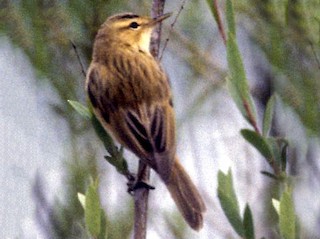Streaked Reed Warbler Acrocephalus sorghophilus Scientific name definitions
- CR Critically Endangered
- Names (25)
- Monotypic
Text last updated October 28, 2014
Sign in to see your badges
Species names in all available languages
| Language | Common name |
|---|---|
| Bulgarian | Амурско шаварче |
| Catalan | boscarla estriada |
| Chinese | 細紋葦鶯 |
| Chinese (Hong Kong SAR China) | 細紋葦鶯 |
| Chinese (SIM) | 细纹苇莺 |
| Croatian | kineski trstenjak |
| Dutch | Chinese rietzanger |
| English | Streaked Reed Warbler |
| English (United States) | Streaked Reed Warbler |
| Estonian | ruuge-roolind |
| Finnish | kiinankerttunen |
| French | Rousserolle sorghophile |
| French (Canada) | Rousserolle sorghophile |
| German | Hirserohrsänger |
| Japanese | セスジコヨシキリ |
| Norwegian | mingsanger |
| Polish | trzcinniczek smugowany |
| Russian | Просяная камышевка |
| Serbian | Prugasti trstenjak |
| Slovak | trsteniarik prosový |
| Spanish | Carricerín Estriado |
| Spanish (Spain) | Carricerín estriado |
| Swedish | streckig rörsångare |
| Turkish | Çin Kındıra Kamışçını |
| Ukrainian | Очеретянка соргова |
Acrocephalus sorghophilus (Swinhoe, 1863)
Definitions
- ACROCEPHALUS
- sorghophila / sorghophilus
The Key to Scientific Names
Legend Overview
Field Identification
12–13 cm; 7·2–9·1 g. Medium-sized reed-warbler with well-graduated tail, rectrices being narrowed at tips. Has black lateral crown-stripe, broad creamy-buff supercilium, yellowish cheeks; above, ground colour ochraceous olive, faint blackish streaks or speckling on crown, mantle and scapulars, plain reddish-olive rump; upperwing-coverts and tertials deep mid-brown, edged ochraceous olive; flight-feathers brown, edged light chestnut-brown, margined with reddish-olive; tail brown, edged and tipped buff; buff-ochre below, whitish throat and belly, inner underwing-coverts edged with very pale rusty ochre; iris dark brown; upper mandible blackish-brown with yellow-ochre edges, whole of lower mandible yellow-ochre; legs plumbeous, paler soles. Sexes alike. Immature is like adult, but more buffy below. Larger A. schoenobaenus typically has slightly warmer- and darker-toned upperparts, with broader and more diffuse and thus less contrasting streaking on mantle, but better-defined crown streaks, plus narrower dark sides to crown.
Systematics History
Subspecies
Distribution
Precise breeding area not known; on the basis of passage records is presumed to breed in NE China (probably wetlands in Hebei, Liaoning, Jilin and Heilongjiang) and the bordering N shore of the R Amur (Amur region of SE Russia) (1). Non-breeding in Philippines.
Habitat
Movement
Diet and Foraging
Sounds and Vocal Behavior
Breeding
Conservation Status
ENDANGERED. Previously considered Vulnerable. Restricted-range species: precise breeding area unknown, but speculated as being in wetlands in Liaoning and Hebei provinces of NE China, which could constitute a new Secondary Area. Uncommon to rare, and local; declining. Estimated world population 2500–10,000 individuals. Rare and local visitor in Philippines, with regular records from Candaba Marsh (SC Luzon); regular also at Dalton Pass (NC Luzon), where fairly large numbers recorded on passage, at least formerly. Declining because of habitat destruction on Philippine wintering grounds, where marshland continuing to be converted to rice cultivation, fish ponds, settlements and factories; habitat loss may also occur on breeding grounds. Fieldwork urgently required in order to locate this species’ breeding areas and to determine its ecological requirements.

- Year-round
- Migration
- Breeding
- Non-Breeding












































